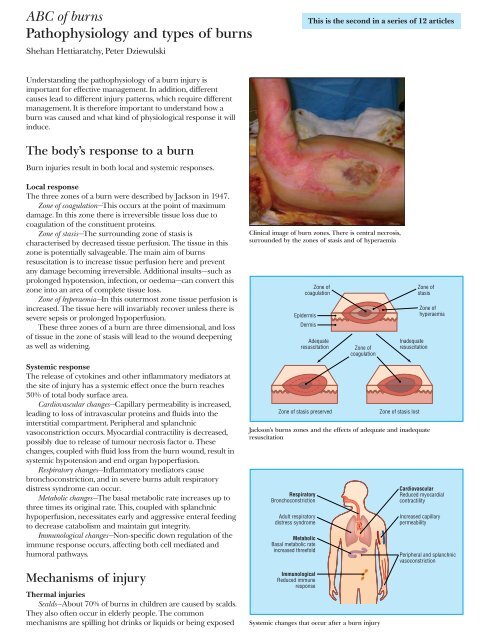ABC of Burns
You also want an ePaper? Increase the reach of your titles
YUMPU automatically turns print PDFs into web optimized ePapers that Google loves.
<strong>ABC</strong> <strong>of</strong> burns<br />
Pathophysiology and types <strong>of</strong> burns<br />
Shehan Hettiaratchy, Peter Dziewulski<br />
This is the second in a series <strong>of</strong> 12 articles<br />
Understanding the pathophysiology <strong>of</strong> a burn injury is<br />
important for effective management. In addition, different<br />
causes lead to different injury patterns, which require different<br />
management. It is therefore important to understand how a<br />
burn was caused and what kind <strong>of</strong> physiological response it will<br />
induce.<br />
The body’s response to a burn<br />
Burn injuries result in both local and systemic responses.<br />
Local response<br />
The three zones <strong>of</strong> a burn were described by Jackson in 1947.<br />
Zone <strong>of</strong> coagulation—This occurs at the point <strong>of</strong> maximum<br />
damage. In this zone there is irreversible tissue loss due to<br />
coagulation <strong>of</strong> the constituent proteins.<br />
Zone <strong>of</strong> stasis—The surrounding zone <strong>of</strong> stasis is<br />
characterised by decreased tissue perfusion. The tissue in this<br />
zone is potentially salvageable. The main aim <strong>of</strong> burns<br />
resuscitation is to increase tissue perfusion here and prevent<br />
any damage becoming irreversible. Additional insults—such as<br />
prolonged hypotension, infection, or oedema—can convert this<br />
zone into an area <strong>of</strong> complete tissue loss.<br />
Zone <strong>of</strong> hyperaemia—In this outermost zone tissue perfusion is<br />
increased. The tissue here will invariably recover unless there is<br />
severe sepsis or prolonged hypoperfusion.<br />
These three zones <strong>of</strong> a burn are three dimensional, and loss<br />
<strong>of</strong> tissue in the zone <strong>of</strong> stasis will lead to the wound deepening<br />
as well as widening.<br />
Systemic response<br />
The release <strong>of</strong> cytokines and other inflammatory mediators at<br />
the site <strong>of</strong> injury has a systemic effect once the burn reaches<br />
30% <strong>of</strong> total body surface area.<br />
Cardiovascular changes—Capillary permeability is increased,<br />
leading to loss <strong>of</strong> intravascular proteins and fluids into the<br />
interstitial compartment. Peripheral and splanchnic<br />
vasoconstriction occurs. Myocardial contractility is decreased,<br />
possibly due to release <strong>of</strong> tumour necrosis factor α. These<br />
changes, coupled with fluid loss from the burn wound, result in<br />
systemic hypotension and end organ hypoperfusion.<br />
Respiratory changes—Inflammatory mediators cause<br />
bronchoconstriction, and in severe burns adult respiratory<br />
distress syndrome can occur.<br />
Metabolic changes—The basal metabolic rate increases up to<br />
three times its original rate. This, coupled with splanchnic<br />
hypoperfusion, necessitates early and aggressive enteral feeding<br />
to decrease catabolism and maintain gut integrity.<br />
Immunological changes—Non-specific down regulation <strong>of</strong> the<br />
immune response occurs, affecting both cell mediated and<br />
humoral pathways.<br />
Mechanisms <strong>of</strong> injury<br />
Thermal injuries<br />
Scalds—About 70% <strong>of</strong> burns in children are caused by scalds.<br />
They also <strong>of</strong>ten occur in elderly people. The common<br />
mechanisms are spilling hot drinks or liquids or being exposed<br />
Clinical image <strong>of</strong> burn zones. There is central necrosis,<br />
surrounded by the zones <strong>of</strong> stasis and <strong>of</strong> hyperaemia<br />
Zone <strong>of</strong><br />
coagulation<br />
Epidermis<br />
Dermis<br />
Adequate<br />
resuscitation<br />
Zone <strong>of</strong> stasis preserved<br />
Zone <strong>of</strong><br />
coagulation<br />
Zone <strong>of</strong><br />
stasis<br />
Inadequate<br />
resuscitation<br />
Zone <strong>of</strong> stasis lost<br />
Jackson’s burns zones and the effects <strong>of</strong> adequate and inadequate<br />
resuscitation<br />
Respiratory<br />
Bronchoconstriction<br />
Adult respiratory<br />
distress syndrome<br />
Metabolic<br />
Basal metabolic rate<br />
increased threefold<br />
Immunological<br />
Reduced immune<br />
response<br />
Systemic changes that occur after a burn injury<br />
Zone <strong>of</strong><br />
hyperaemia<br />
Cardiovascular<br />
Reduced myocardial<br />
contractility<br />
Increased capillary<br />
permeability<br />
Peripheral and splanchnic<br />
vasoconstriction



